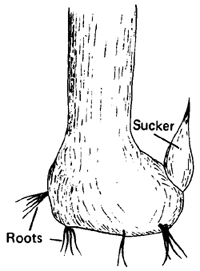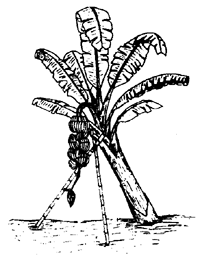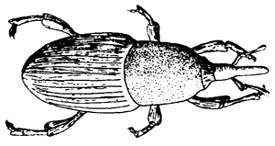For a fine plantation, you must:
The grass grows a lot
when the banana plant is small.
When the banana has grown up,
the grass dies, because it has no light.
There is no need to sow a cover plant.
If the grass does not die, apply Gramoxone.
Mix 0.4 litres of the product
with 400 litres of water to treat one hectare.
Add a spreader to the mixture
to make it stick to the grass better.
You can put down a mulch (see Booklet No.5, page 18)
of dry grass and leaves
at the end of the rainy season.
This vegetation will rot, and make humus;
it will help to keep the soil moist during the dry season.
In low-lying ground there is too much water.
It must be drained (see page 9).
In other places, the bananas do not get enough water.
So you must give the bananas water by irrigating them
(see Booklet No. 6, pages 18–19).
Look for a stream where there is water all the year.
Dig ditches between the rows of bananas.
Lead the water from the stream with dams and ditches,
so that the soil of the plantation is always moist.
You added organic matter in the form of the compost
that you put into the planting holes.
The leaves and stalks cut from banana plants
rot on the soil and add more organic matter.
But the plantation still needs mineral salts
(see Booklet No. 1, page 19).
Bananas like potassium
(see Booklet No. 6, page 11).
You can give a banana plant each year the following:
Nitrogen (see Booklet No. 6, page 10)
750 grammes of ammonium sulphate
or 300 grammes of urea.
Phosphorus (see Booklet No. 6, page 10)
300 grammes of dicalcium phosphate
or 500 grammes of Thomas slag (Bessemer basic slag).
Potassium (see Booklet No. 6, page 11)
600 grammes of potassium chloride.
Give also 500 grammes of dolomitic limestone
per plant once a year, in one application.
The nitrogen and the potassium
are given in several applications (four or five times).
The phosphorus and the lime
are applied at the end of the dry season
or at the end of the rainy season.
The fertilizer will not be washed away by the rain.
If the banana plants are irrigated,
fertilizer may be given during the dry season.
Instead of applying several different fertilizers,
you can use one compound fertilizer
(see Booklet No. 6, page 11).
For young plants
you can give 1.5 kilogrammes of 10-10-20 fertilizer
per plant per year, in several applications.
For bananas in production,
you can give 1.5 kilogrammes of 5-12-24 fertilizer
per plant per year, in several applications.
In addition, give 500 grammes of dolomitic limestone
in one application per plant per year.
Pruning banana plants is called suckering.
There are several ways of doing this.
We shall deal with only one way.
The offshoot that you planted is called the parent plant.
Four months after planting,
cut away all the suckers that have sprouted
except one.
Cut the suckers off at ground level
or below the surface of the ground.
Keep the best sucker,
the one that is best placed.
The plantation is laid out in rows,
so that if the suckers are in the same line,
the plantation rows are unchanged.
Four months after this first suckering,
the parent plant is 8 months old
and the one remaining sucker is 4 months old.
Once again, cut off all the other suckers
except one.
| About 10 months after planting (taking Poyo bananas as an example), the parent plant produces fruits. |  |
| Harvest these fruits, and cut down the parent plant. The first generation sucker is now 6 months old and the second generation is 2 months old. | |
| You can use a machete or axe to cut out the suckers you do not want to keep. | |
| Underground stem of banana | |
The fruit of banana plants is very heavy.
The plant bends under the weight,
and the wind may blow it down.
You must prevent it from falling.
To do this, cut thick bamboos about 3 metres long.
Make a hole at one end of each bamboo.

| Tie two bamboos together with a piece of wire 40 centimetres long. |
| Put the bamboos in place, as shown in the drawing, when the flowers have appeared and turned down to the earth. The bamboos hold up the banana plant. It rests on the wire between the two bamboos. |
When the plant has flowered,
the male flower bud is a long way
from the lowest hand of female flowers.
Twist the bud to break it off,
and cut off the lowest hand of the bunch.
Cover the whole bunch with plastic
when the hands turn upward.
See that there are holes in the plastic
so that the bunch can breathe.
The plastic protects the bunch from sun and rain
and from sprays for leaf spot disease (see page 17).
If you do not cover the bunch with plastic,
the bananas will get black patches
and will not be fit to sell.
The banana is attacked
by many insects and diseases.
• Banana weevil

Weevil
This insect
makes holes in the base of the banana plant
and lays its eggs in these holes.
The eggs turn into little weevils.
They eat out the heart of the banana plant.
You do not see the weevils,
but if the fruit bunch does not develop,
or if the bunch is small and badly shaped,
there may be weevils.
To find out if there are weevils in the plantation,
cut pieces of the plant's apparent trunk lengthwise.
Put two pieces on the ground near each plant.
Look every day at these pieces.
If there are weevils in the plantation,
they will hide under the pieces of “trunk.”
To control the weevils, use BHC.
Put 25 to 30 grammes of BHC round each plant.
• Banana eelworm or nematode
These are tiny worms
that are found in the soil.
They eat the roots,
and once the banana has no roots,
it cannot feed,
and may be blown over by the wind.
Make sure the bananas have no eelworms
when they are planted.
Before planting,
dip the suckers in lukewarm water,
or in water mixed with Némagon.
If there are eelworms in the plantation,
put Némagon in the soil.
• Other pests
There are other pests that attack bananas
such as thrips, aphids, scale insects, etc.
They are controlled with BHC, Aldrin or Dieldrin.
• Panama disease
This disease is caused
by a tiny fungus in the soil.
It makes the leaves break.
If you cut the banana plant,
the apparent trunk is coloured brownish red.
To control the disease,
plant resistant dwarf varieties
such as Poyo or Lacatan.
These bananas are very resistant to Panama disease.
The Gros Michel variety is not resistant.
• Leaf spot disease (see page 15)
This disease is caused by a fungus.
The leaves show grey spots ringed with dark yellow.
The banana plant cannot breathe
and the yield falls greatly.
The disease appears
when the temperature is high
and the air is very humid.
It is treated by spraying with mineral oil,
using 12 to 20 litres per hectare.
• Bunchy top
This disease is carried by an aphid.
Dark green streaks appear on the leaves.
The leaves do not grow long and are wavy at the edges.
Dig up the diseased banana plants.
The aphid can be controlled with Malathion or Dieldrin.
• “Cigar-end” rot
The fruits go rotten.
The disease begins at the tips of the bananas.
To control this disease,
cut off the last hand that does not grow
and break off the male flower bud (see page 15).
• Mosaic disease
Small yellow patches appear on the leaves
toward the midrib (see Booklet No. 2, page 14).
You can see them easily
by holding the leaf up to the sun.
You can also see little holes in the leaf-stalk.
To control the disease,
dig up the plants and wait a long time
before planting again in the same place.
• False mosaic disease
Light spots of varying colour can be seen on the leaves.
This is not a serious disease.
It may be caused by lack of copper in the soil.
• Lack of zinc
The plant's leaves do not grow very long,
and are pale, narrow and pointed.
The disease is cured by sprinkling on the ground
50 grammes of zinc sulphate per plant.
• Lack of magnesium
The disease is cured by applying dolomitic limestone.